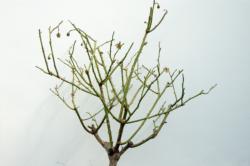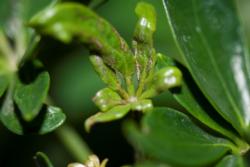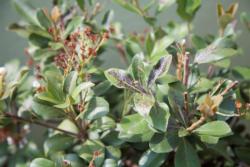Summer 2016: Chilli thrips
by James A. Bethke
For years I have been dreading the arrival of the invasive chilli thrips, Scirtothrips dorsalis Hood. It’s been in Texas and Florida for some time now, and I was hopeful that the bug just didn’t like California. Regrettably, it has arrived.
Scientists believe that chilli thrips originated either in Southeast Asia or in the Indian subcontinent, but it is now widely distributed. Chili thrips was first reported in Florida on October 2, 1991 with subsequent occurrences in 1994, 2004, 2005 and 2007 in various counties of Florida, and it was observed in southeastern Texas in 2005 on landscape roses and on peppers in retail centers. In August of 2015 chilli thrips were found at several residential properties in Orange County, California, and in October, it was detected on roses at the Los Angeles County Arboretum and Botanic Garden. Initially, the pest was rated “Q” and required regulatory action. Thereafter, it was determined that chilli thrips cannot be eradicated, and it is likely to become widespread in California. Recently, it was reduced to a “B” rated pest in California. The B rating still means that some counties may treat this pest as a significant pest, and that it may need local regulation.
Infestations of the invasive chilli thrips poses a number of challenges including:
- Chilli thrips resemble many other thrips species.
- Unlike other thrips, pupae of chilli thrips are generally found on leaves, leaf litter, or on the axils of leaves, in curled leaves, or under the calyxes of flowers and fruits.
- Chilli thrips damage resembles herbicide damage, micronutrient deficiency, or an aphid infestation.
- Insecticide resistance is common.
- Chilli thrips have been implicated in tospovirus transmission.
Chillithrips are known to infest a wide variety of host plants belonging to more than 200 plant species in 70 plant families, most of them ornamental. It can also attack many trees and tree fruits such as mango, apple, pears, citrusandlychee, and it can attack many field crops such as strawberries, peppers, eggplant, tomatoes, corn and cotton. Infested plants become stunted, and severe infestations can result in total defoliation of the host. Damage to roses includes distorted and elongated foliage, scarred flower buds, and brown, angular spots on the new growth of the roses and defoliation (fig. 1).

On many hosts, chilli thrips also start feeding on the upper surface of leaves when the infestation is heavy (fig. 2– 3). Chilli thrips are principally a landscape pest and will damage many of the common landscape plants in California including Indian hawthorne, viburnum, shefflera, star jasmine, podocarpus, pittosporum, pyracantha and roses.
Fig. 2. Chilli thrips damage to terminal growth of shefflera. Photo: Lance S. Osborne, University of Florida.
Research suggests thatfoliar sprays with insecticides containingacephate,imidacloprid, orspinosad are effective for pest control on ornamental landscape plants.Chillithrips are generally resistant to thepyrethroids such asbifenthrin,cyfluthrin andpermethrin, so they are not recommended for control, and are more damaging to beneficial insects.

If you suspect that you have chilli thrips on your plants you are encouraged to seek expert help in identifying the pest. Identifying the pest will help pest control advisors and farm advisors make control recommendations.
References
Arakelian G. 2016. Chilli Thrips (Scirtothrips dorsalis). Los Angeles County Department of Agricultural Commissioner/Weights and Measures, January, 2016. https://www.cdfa.ca.gov/plant/ppd/PDF/Scirtothrips_dorsalis.pdf.
Brown SH, Osborne LS. Chilli Thrips (Scirtothrips dorsalis): A Landscaper’s Guide. University of Florida and IFAS Extension Lee County, 2009. http://lee.ifas.ufl.edu/Hort/GardenPubsAZ/ChilliThrips.pdf.
Hodges G, Edwards GB, Dixon W. 2005. Chilli thrips Scirtothrips dorsalis Hood (Thysanoptera: Thripidae): A new pest thrips for Florida. Pest Alert, Oct. 2005. Florida Department of Agriculture and Consumer Services, Division of Plant Industry. http://www.freshfromflorida.com/content/download/68187/1612823/Pest_Alert_-_Scirtothrips_dorsalis,_Chilli_Thrips.pdf.
Kumar V, Seal DR, Kakkar G. 2014. Chilli thrips Scirtothrips dorsalis Hood (Insecta: Thysanoptera: Thripidae). Featured Creatures, January 2014. Entomology and Nematology Department, University of Florida. http://entnemdept.ufl.edu/creatures/orn/thrips/chilli_thrips.htm. Also: http://edis.ifas.ufl.edu/pdffiles/IN/IN83300.pdf.
Ludwig SW, Bográn C. 2007. Chilli Thrips: A New Pest in the Home Landscape. Texas Cooperative Extension. http://extentopubs.tamu.edu/pdf/EEE-00041.pdf.
McDonough F. 2015. Chilli thrips: Rose disfiguring pest possibly transported by recent hurricane. Los Angeles County Arboretum and Botanic Garden, October 29, 2015. http://arboretumplantinfo.blogspot.com/2015/10/chilli-thrips-rose-disfiguring-pest.html.
Osborne LS. Insect and Related Pests of Foliage Plants: Chilli Thrips, Scirtothrips dorsalis Hood. University of Florida Institute of Food and Agricultural Sciences, October 2015.http://mrec.ifas.ufl.edu/lso/thripslinks.htm.
Osborne LS. Insect and Related Pests of Foliage Plants: Chilli Thrips, Scirtothrips dorsalis Hood Documents. University of Florida Institute of Food and Agricultural Sciences, October 2015.http://mrec.ifas.ufl.edu/lso/thripslinks.htm#DOCUMENTS.
Martin KW, Hodges AC, Leppla NC. 2012. Chilli thrips. Citrus Pests, June 2012. Department of Entomology, University of Florida and Identification Technology Program, CPHST, PPQ, APHIS, USDA; Fort Collins, CO. http://idtools.org/id/citrus/pests/factsheet.php?name=Chilli+thrips.
Scirtothrips dorsalis. Wikipedia, June 20, 2016.https://en.wikipedia.org/wiki/Scirtothrips_dorsalis.












